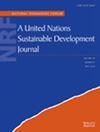Impact of subsidy on the new type of forestry operating entity's input: Moderating effect of the rising labor cost
IF 3.7
4区 社会学
Q2 ENVIRONMENTAL SCIENCES
引用次数: 0
Abstract
In an era marked by escalating social aging and labor costs, the forestry sector faces a critical juncture for sustainable development. Amidst these challenges, an opportunity arises to enhance forestry practices by examining the moderating impact of rising labor costs on emerging forestry entities. Employing instrumental variable Tobit models, this study rigorously analyzes the influence of subsidy levels on input factors within these enterprises. Drawing on a comprehensive data set of 485 survey responses from 15 counties and 6 provinces, this investigation reveals significant insights into the dynamics of forestry subsidies, input levels, and labor costs. It identifies a substantial positive correlation between forestry subsidies and both capital and labor inputs within these entities. However, it is the burgeoning labor costs that emerge as a pivotal driver, prompting a strategic reallocation of labor inputs toward capital factors. This strategic shift is driven by a nuanced interplay between labor‐saving capital and labor, resulting in a dynamic substitution effect that concurrently augments employed labor inputs. These findings underscore the imperative for tailored strategies to address the challenges posed by escalating labor costs and social aging within the forestry sector. In response, this study advocates for proactive approaches to forestry subsidy standards, emphasizing dynamic implementation to facilitate increased inputs. Additionally, broader allocation of forestry subsidies and an accelerated drive toward forestry transformation are identified as essential pathways toward fostering sustainable development and resilience amidst evolving socio‐economic landscapes.补贴对新型林业经营主体投入的影响:劳动力成本上升的缓和效应
在社会老龄化和劳动力成本不断攀升的时代,林业部门面临着可持续发展的关键时刻。在这些挑战中,通过研究劳动力成本上升对新兴林业实体的调节作用,为加强林业实践提供了机遇。本研究采用工具变量 Tobit 模型,严格分析了补贴水平对这些企业投入要素的影响。本研究利用来自 15 个县和 6 个省的 485 份调查问卷的综合数据集,揭示了林业补贴、投入水平和劳动力成本的动态变化。调查发现,林业补贴与这些实体的资本和劳动力投入之间存在显著的正相关关系。然而,劳动力成本的急剧上升才是关键驱动因素,促使劳动力投入向资本要素进行战略性重新分配。这种战略转移是由节省劳动力的资本和劳动力之间微妙的相互作用所驱动的,从而产生了一种动态替代效应,同时增加了所使用的劳动力投入。这些发现强调,必须制定有针对性的战略,以应对林业部门劳动力成本上升和社会老龄化带来的挑战。为此,本研究主张积极制定林业补贴标准,强调动态实施,以促进投入的增加。此外,更广泛地分配林业补贴和加速推动林业转型被认为是在不断变化的社会经济环境中促进可持续发展和复原力的重要途径。
本文章由计算机程序翻译,如有差异,请以英文原文为准。
求助全文
约1分钟内获得全文
求助全文
来源期刊

Natural Resources Forum
环境科学-环境科学
CiteScore
6.10
自引率
0.00%
发文量
24
审稿时长
>36 weeks
期刊介绍:
Natural Resources Forum, a United Nations Sustainable Development Journal, focuses on international, multidisciplinary issues related to sustainable development, with an emphasis on developing countries. The journal seeks to address gaps in current knowledge and stimulate policy discussions on the most critical issues associated with the sustainable development agenda, by promoting research that integrates the social, economic, and environmental dimensions of sustainable development. Contributions that inform the global policy debate through pragmatic lessons learned from experience at the local, national, and global levels are encouraged.
The Journal considers articles written on all topics relevant to sustainable development. In addition, it dedicates series, issues and special sections to specific themes that are relevant to the current discussions of the United Nations Commission on Sustainable Development (CSD). Articles must be based on original research and must be relevant to policy-making.
Criteria for selection of submitted articles include:
1) Relevance and importance of the topic discussed to sustainable development in general, both in terms of policy impacts and gaps in current knowledge being addressed by the article;
2) Treatment of the topic that incorporates social, economic and environmental aspects of sustainable development, rather than focusing purely on sectoral and/or technical aspects;
3) Articles must contain original applied material drawn from concrete projects, policy implementation, or literature reviews; purely theoretical papers are not entertained.
 求助内容:
求助内容: 应助结果提醒方式:
应助结果提醒方式:


